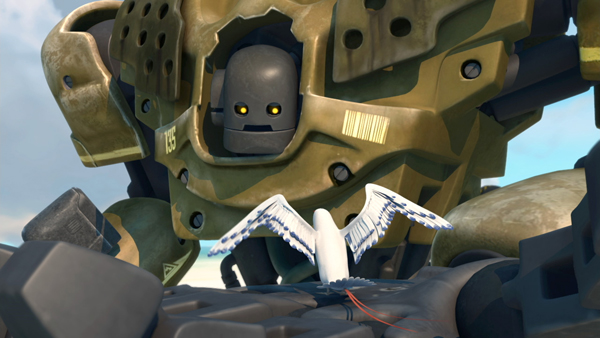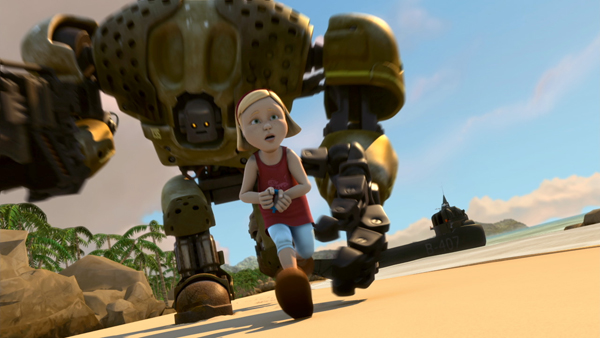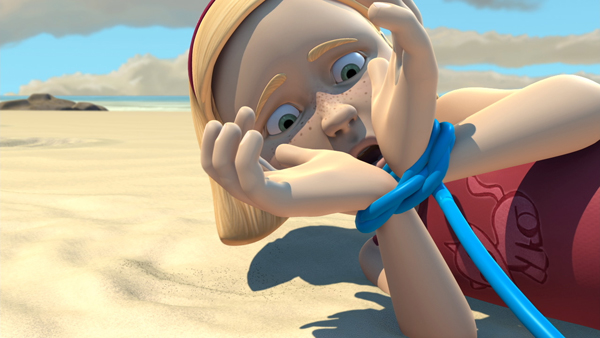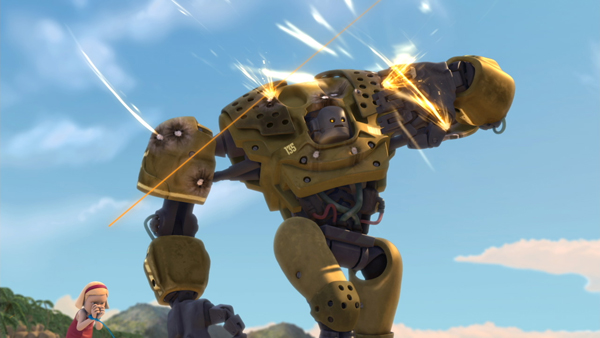| The production served as a learning ground for David, whose film background had been in VFX until then. As he finalised the script, he also became the director and completed about 20 percent of the film’s animation, though he had never done character animation before. The film, produced by David’s company David Gould Studios, received development and production funding from Screen Australia. It was entered in the Gold Coast Film Fantastic, November 2009, where it made Official Selection.
Simple Concept
During concept design, David worked with several different artists in various locations including France, America, Spain and here in Australia. The overriding theme in the designs was simplicity. Describing the robot soldiers in his film, David said, “I didn't want the robots to be like the Japanese mecha with advanced systems and power sources. The robots are very simple, hydraulic machines. If a part fails or is destroyed, you simply replace it with another part. Their simplicity makes them more robust.”
Nor did he want to spend too much time on detail in building and texturing the characters. His focus was on creating a solid story and he spent more time and resources on animation than on building intricate, photorealistic characters and models. “In ten years time, no matter how good your technology is, it will appear outdated, but if the story is good it the film will live on.”
Modelling
All the characters, props and sets were modelled in Maya as a standard polygonal cage that was later subdivided in the rendering software. The hydraulic cables in the robot use NURBS but virtually nothing else. Using the low-resolution polygons meant that the modelling team could use the same models for the animations as well as the final renders, and didn't have to swap the models out and replace them with higher resolution models at render time. They modelled and rigged all the characters once and could use them for previz, animation and final rendering, although modifications and improvements to the characters continued right up until the final day of animation.
A human character in the story, a little girl, received more complex treatment. “We added more facial and other controls to enable more expression in the girl. We wanted fine nuances to be portrayed and had to add more controls to her lips and particularly around her eyes and eyebrows,” David said.
“We didn't do any simulations of cloth or ropes. They took too long and often didn't produce a very good result. In fact, the girl's hair and cloth have controllers that are hand-animated. This way we had absolute control and weren't fighting against a simulated result. In computer animation you get nothing for free,” he joked. “The jungle is made up of thousands and thousands of hand-made trees including swiss-cheese plants and banana palms.”
Complex Wings
All the rigs allowed a mix between inverse kinematics, IK, and forward kinematics, FK. You could switch between the two at any point in the animation. You could have the girl's left arm in FK and her right arm in IK depending on the requirements. For the robot I developed some custom plugins to control the pistons and hydraulics. The animator can move the arm or torso and the pistons and hydraulic's orientation is calculated automatically.”
The bird's wings were a complex rigging problem. When they fold, all the individual feathers must fold over each other. The final rig has a separate control for each of the feathers. We set up poses for the wings fully extended, then one-third closed, two-thirds closed, then fully closed. The feathers were individually posed for each of these different stages of closure. The entire pose for both wings were then stored. David developed a system to store poses and reapply them at any point, so that when an animator needed to close the wings they could instantly apply the various wing-closure poses as needed.
Camera Angles
Animation got underway as the rigging and modelling were completed. All animation was done in Maya. All the characters use standard Maya tools, other than a few custom plugins David developed. In some cases, the camera would be created first and the animator would work to that. “I created the cameras and adjusted them as needed as part of the previz stage,” said David. “Other times, the animator would produce some animation and then I would work out the best camera angles to cover that action. So in that way, it is like live-action filming.
“The views from all the different cameras were output using the Maya playblast feature, and I would add them to the edit. I could then see which angles worked and which didn't, choose the final camera and the animator would continue their work with that one. We used Premiere Pro to edit, but are considering FCP for future productions.”
Reference
David downloaded lots of photo reference so the team could see the different poses for the birds. The photos also became important for the girl. What makes a young girl appealing? How do they hold themselves when standing? A lot of video reference was also downloaded for the girl and birds. For the robot, he collected hydraulic crane reference and other machinery. “We didn't use any other reference for the robots since it was understood that they were 10 foot tall and weighed over a ton. It was then a task of making the character's size and weight work on the screen but I didn't want the animators looking at anime - this wasn't the style I was going for.”
For complex motions, the animators would record their own video reference. For example where the robot was doing several actions such as picking up the grenade launcher, spinning around, running across the barge, stopping and firing, the animator recorded himself performing these actions because it helped them understand the transfer of weight, the location and orientation of the pelvis. Then, of course, he takes artistic license and makes it believable for a much large and heavier robotic character.
Raytracing
The rendering was split into multiple passes including occlusion, key light and fill lights. Mental Ray was used to render the film because David wanted to apply raytracing. Although the characters, sets and overall style of the film appear simplistic, it still uses raytracing to achieve realistic outdoor lighting.
The island is intended to be a beautiful place and the realistic lighting helped portray this better. “It was important to me that the characters really inhabited this outdoor location,” said David. “On a sunny day, there is a huge hemisphere of blue light above (skylight) and a huge area of golden sand underneath. This meant that standard lights wouldn't work. I wanted to ensure that the blue lighting from above and the warm bounce light from below got inside the intricate parts making up the robot. Therefore, ambient occlusions passes were rendered so that realistic indirect bounce lighting could be taken into account. Otherwise, the characters would have had lots of dark areas, which wouldn’t happen in an open outdoor setting.”
Iteration
David said that spending so much time in the screenwriting, storyboarding and previs stages was valuable for this film. For example, in the original script, the young girl’s character ‘Jenny’ and the robots talked. Many script revisions later, it was decided the film should have no dialog, to make the film more accessible and emphasise the use of animation to communicate feelings. Early drafts of the script also included Jenny’s father, the air-force pilot flying the plane when it was shot down by the robot.
Early drafts placed a greater focus on the two sides of the story, the robot’s side and the girl’s, but later it focused on the robot's point of view. “By doing countless iterations of the storyboarding and previz stages you could effectively make the entire film many times over,” David said. “This meant that we could identify areas that weren't working and try out alternatives. Some worked, others didn't. For every idea that made it to the final film many others got thrown away.
“I think that this is the power of animation: the ability to reiterate and improve means you refine the film until it is the best it can be. When shooting live-action you don't get that opportunity. More importantly, you only see the full film once it has been shot and edited. In animation you get to see the entire film many times over, perhaps in a basic form but seeing the entire film is really important because you need to develop a film as a whole.
Back to the Drawing Board
When we setup our company we asked ourselves, ‘We don't have a great deal of money and we can't compete with the major studios, so what can we do well?’ We lacked the hardware and software resources of the majors, but I saw this in many ways as a blessing. I wanted to move away from the fine tuning of photorealism that eats up time and energy, and focus more on strengthening the story. Our main advantage is that there is no monopoly on good storytelling. Anyone can sit at a computer and write.
“Should the film meet with some degree of success, I think it will be because we never stopped improving the story. While some areas continued to niggle at me, I couldn't let them go, even though our producer wanted to move to the next stage. It had to be fixed – immediately - at the storyboard and previz stage. Once the previz was finaled and locked off and we got into animation, lighting and rendering, we didn't add or remove a single shot.
I'm exploring how to apply this approach of ‘remaking’ your entire film several times over to live-action film productions. There are several ways I think this can happen, but the result is that the audience doesn't see version 1.0 of the film, it sees version 20.0. This version is clearly going to be better than having only produced the first one. Seeing and assessing the film as a whole is the key.
|
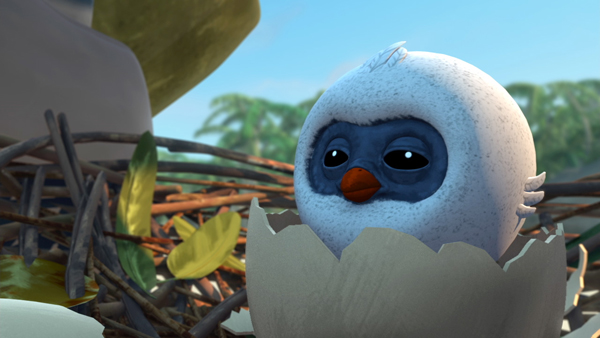 He started in January 2006, originally planning to shoot the film as live-action,
He started in January 2006, originally planning to shoot the film as live-action,